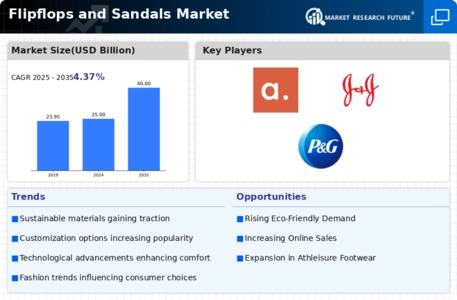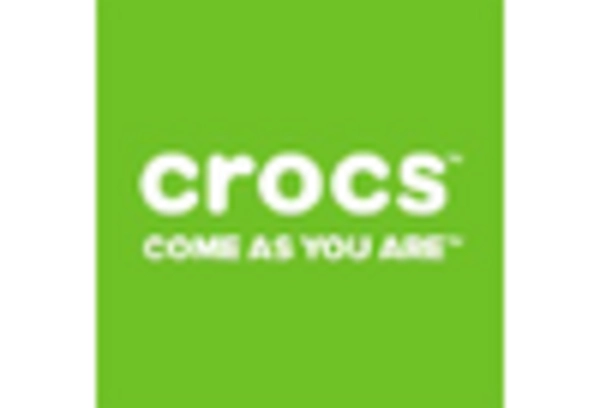Rising Consumer Demand
The Global Flipflops and Sandals Market Industry experiences a notable increase in consumer demand, driven by a growing preference for casual and comfortable footwear. In 2024, the market is projected to reach 25 USD Billion, reflecting a shift in lifestyle choices towards more relaxed and versatile footwear options. This trend is particularly evident among younger demographics, who prioritize comfort without compromising style. The increasing popularity of outdoor activities and beach vacations further fuels this demand, as flipflops and sandals are often the footwear of choice for such occasions. As a result, manufacturers are focusing on innovative designs and materials to cater to this evolving consumer preference.
Diverse Product Offerings
The Global Flipflops and Sandals Market Industry benefits from a diverse range of product offerings, catering to various consumer preferences and occasions. Manufacturers are increasingly introducing specialized designs for different activities, such as beachwear, sports, and casual outings. This diversification not only attracts a wider audience but also encourages repeat purchases as consumers seek footwear that meets their specific needs. The market's projected growth to 40 USD Billion by 2035 indicates the potential for continued innovation and expansion in product lines. As brands strive to differentiate themselves, the emphasis on unique designs and functionalities is likely to shape the future of the industry.
Market Growth Projections
The Global Flipflops and Sandals Market Industry is poised for substantial growth, with projections indicating a compound annual growth rate of 4.37% from 2025 to 2035. This growth trajectory reflects the increasing consumer inclination towards casual footwear, coupled with the expansion of retail channels. As the market evolves, it is expected to reach 40 USD Billion by 2035, driven by factors such as rising disposable incomes and changing lifestyle preferences. The positive outlook for the industry suggests that brands will continue to innovate and adapt to meet the demands of a dynamic consumer base, ensuring sustained growth in the coming years.
Sustainable Footwear Trends
Sustainability emerges as a pivotal driver within the Global Flipflops and Sandals Market Industry, as consumers increasingly seek eco-friendly options. Brands are responding by incorporating sustainable materials, such as recycled plastics and organic cotton, into their product lines. This shift not only aligns with consumer values but also addresses environmental concerns associated with traditional footwear production. Companies that prioritize sustainability may gain a competitive edge, appealing to environmentally conscious consumers. As the market evolves, it is anticipated that the demand for sustainable flipflops and sandals will continue to grow, potentially influencing market dynamics and product offerings in the coming years.
Expansion of E-commerce Platforms
The rise of e-commerce significantly influences the Global Flipflops and Sandals Market Industry, providing consumers with convenient access to a wide range of products. Online shopping platforms enable brands to reach a global audience, facilitating the growth of direct-to-consumer sales. This trend is particularly relevant in 2024, as the market is expected to expand to 25 USD Billion, with e-commerce playing a vital role in this growth. The convenience of online shopping, coupled with targeted marketing strategies, allows brands to engage with consumers effectively. As e-commerce continues to evolve, it is likely to reshape the retail landscape for flipflops and sandals, driving further market expansion.
Technological Advancements in Footwear
Technological innovations play a crucial role in shaping the Global Flipflops and Sandals Market Industry. Advancements in materials and manufacturing processes enhance the comfort, durability, and performance of flipflops and sandals. For instance, the introduction of lightweight, breathable materials and ergonomic designs caters to the needs of active consumers. Additionally, the integration of smart technologies, such as moisture-wicking fabrics and cushioning systems, further elevates the user experience. As these technologies become more prevalent, they are likely to attract a broader consumer base, contributing to the market's growth trajectory. The ongoing evolution of footwear technology suggests a promising future for the industry.

















Leave a Comment